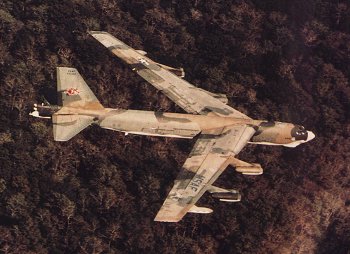B-52 Stratofortress

Mission
Air Combat Command's B-52 is a long-range, heavy bomber that can perform a variety of missions. The bomber is capable of flying at high subsonic speeds at altitudes up to 50,000 feet (15,166.6 meters). It can carry nuclear or precision guided conventional ordnance with worldwide precision navigation capability.
Features
In a conventional conflict, the B-52 can perform strategic attack, air interdiction, offensive counter-air and maritime operations. During Desert Storm, B-52s delivered 40 percent of all the weapons dropped by coalition forces. It is highly effective when used for ocean surveillance, and can assist the U.S. Navy in anti-ship and mine-laying operations. Two B-52s, in two hours, can monitor 140,000 square miles (364,000 square kilometers) of ocean surface.
All B-52s are equipped with an electro-optical viewing system that uses
platinum silicide forward-looking infrared and high resolution low-light-level
television sensors to augment targeting, battle assessment, and flight safety,
thus further improving its combat ability and low-level flight capability.
Pilots wear night vision goggles (NVG) to enhance their vision during night
operations. Night vision goggles provide greater safety during night operations
by increasing the pilot's ability to visually clear terrain, avoid enemy
radar and see other aircraft in a covert/lights-out environment.
Starting in 1989, on-going modifications incorporates the global positioning
system, heavy stores adapter beams for carrying 2,000 pound munitions, and
a full array of advance weapons currently under development.
The use of aerial refueling gives the B-52 a range limited only by crew endurance.
It has an unrefueled combat range in excess of 8,800 miles (14,080 kilometers).
The aircraft's flexibility was evident in Operation Desert Storm and again
during Operations Allied Force. B-52s struck wide-area troop concentrations,
fixed installations and bunkers, and decimated the morale of Iraq's Republican
Guard. The Gulf War involved the longest strike mission in the history of
aerial warfare when B-52s took off from Barksdale Air Force Base, La., launched
conventional air launched cruise missiles and returned to Barksdale -- a
35-hour, non-stop combat mission.
During Operation Allied Force, B-52s opened the conflict with conventional cruise missile attacks and then transitioned to delivering general purpose bombs and cluster bomb units on Serbian army positions and staging areas.
Background
For more than 40 years B-52 Stratofortresses have been the backbone of the manned strategic bomber force for the United States. The B-52 is capable of dropping or launching the widest array of weapons in the U.S. inventory. This includes gravity bombs, cluster bombs, precision guided missiles and joint direct attack munitions. Updated with modern technology the B-52 will be capable of delivering the full complement of joint developed weapons and will continue into the 21st century as an important element of our nation's defenses. Current engineering analyses show the B-52's life span to extend beyond the year 2040.
The B-52A first flew in 1954, and the B model entered service in 1955. A total of 744 B-52s were built with the last, a B-52H, delivered in October 1962. Only the H model is still in the Air Force inventory and is assigned to Air Combat Command and the Air Force Reserves.
The first of 102 B-52H's was delivered to Strategic Air Command in May 1961. The H model can carry up to 20 air launched cruise missiles. In addition, it can carry the conventional cruise missile that was launched in several contingencies during the 1990s, starting with Operation Desert Storm and culminating with Operation Allied Force.
General Characteristics
Primary
Function: Heavy bomber
Contractor: Boeing
Military Airplane Co.
Power
Plant: Eight Pratt & Whitney engines TF33-P-3/103 turbofan
Thrust: Each
engine up to 17,000 pounds
Length: 159
feet, 4 inches (48.5 meters)
Height: 40
feet, 8 inches (12.4 meters)
Wingspan: 185
feet (56.4 meters)
Speed: 650
miles per hour (Mach 0.86)
Ceiling: 50,000
feet (15,151.5 meters)
Weight: Approximately
185,000 pounds empty (83,250 kilograms)
Maximum
Takeoff Weight: 488,000 pounds (219,600 kilograms)
Range: Unrefueled
8,800 miles (7,652 nautical miles)
Armament: Approximately 70,000 pounds (31,500 kilograms)
mixed ordnance -- bombs, mines and missiles. (Modified to carry air-launched
cruise missiles)
Crew: Five
(aircraft commander, pilot, radar navigator, navigator and electronic warfare
officer)
Accommodations: Six
ejection seats
Unit
Cost: $53.4 million (fiscal 98 constant dollars)
Date
Deployed: February 1955
Inventory: Active
force, 85; ANG, 0; Reserve, 9
